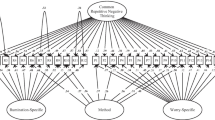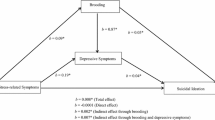Abstract
Both perceived stress and negative recurrent thinking (rumination and worry) have been associated with depressive symptoms. However, no research to date has investigated the association between perceived stress and negative recurrent thinking. In the present study we aimed to explore whether perceived stress and negative recurrent thinking are associated and whether negative recurrent thinking moderates the relationship between perceived stress and depressive symptoms. A convenience sample of 273 undergraduate students completed the Perceived Stress Scale, the Ruminative Responses Scale-10, the Penn State Worry Questionnaire and the Hospital Anxiety and Depression Scale 2 weeks prior to sitting mid-year examinations. Correlation analyses showed that perceived stress, rumination and worry were positively and significantly associated with depressive symptoms and that perceived stress was positively and significantly associated with rumination and worry. A moderation analysis confirmed that negative recurrent thinking moderated the relationship between perceived stress and depressive symptoms. The implications of these findings are discussed.

Similar content being viewed by others
References
Bergdahl, J., & Bergdahl, M. (2002). Perceived stress in adults: Prevalence and association of depression, anxiety and medication in a Swedish population. Stress and Health, 18, 235–241.
Borkovec, T. D., Ray, W. J., & Stober, J. (1998). Worry: A cognitive phenomenon intimately linked to affective, physiological and interpersonal behavioral processes. Cognitive Therapy and Research, 22, 561–576.
Borkovec, T. D., Robinson, E., Pruinsky, T., & DePree, J. A. (1983). Preliminary exploration of worry: Some characteristics and processes. Behaviour Research and Therapy, 21, 9–16.
Calmes, C. A., & Roberts, J. E. (2007). Repetitive thought and emotional distress: Rumination and worry as prospective predictors of depressive and anxious symptomatology. Cognitive Therapy and Research, 30, 343–356.
Caselli, G. (2013). Tecniche di colloquio metacognitivo [Metacognitive therapeutic interview techniques]. In G. M. Ruggiero & S. Sassaroli (Eds.), Il Colloquio in Psicoterapia Cognitiva. Tecnica e Pratica Clinica [The Interview in Cognitive Psychotherapy. Techniques and Clinical Practice] (pp. 211–222). Milano: Raffaello Cortina Editore.
Chan, S. M., Chan, S. A. & Kwok, W. W. (2014). Ruminative and catastrophizing cognitive styles mediate the association between daily hassles and high anxiety in Hong Kong adolescents. Child Psychiatry and Human Development. Published electronically 26th February 2014.
Chang, E. C. (1998). Does dispositional optimism moderate the relation between perceived stress and psychological well-being? A preliminary investigation. Personality and Individual Differences, 25, 233–240.
Cohen, S., & Janicki-Deverts, D. (2012). Who’s stressed? Distributions of psychological stress in the United States in probability samples from 1983, 2006 and 2009. Journal of Applied Social Psychology, 42, 1320–1334.
Cohen, S., Kamarck, T., & Mermelstein, R. (1983). A global measure of perceived stress. Health and Social Behavior, 24, 385–396.
Dryden, W. (2011). Dealing with clients’ emotional problems in life coaching. A rational-emotive and cognitive behaviour therapy (RECBT) approach. Hove: Routledge.
Ellis, A. (1962). Reason and emotion in psychotherapy. Secaucus, NJ: The Citadel Press.
Folkman, S., & Lazarus, R. S. (1985). If it changes it must be a process: Study of emotion and coping during three stages of a college examination. Journal of Personality and Social Psychology, 48, 150–170.
Fresco, D. M., Frankel, A. N., Mennin, D. S., Turk, C. L., & Heimberg, R. G. (2002). Distinct and overlapping features of rumination and worry: The relationship of cognitive production to negative affective states. Cognitive Therapy and Research, 26, 179–188.
Hong, R. Y. (2007). Worry and rumination: Differential associations with anxious and depressive symptoms and coping behavior. Behaviour Research and Therapy, 45, 277–290.
Jöreskog, K. G., & Sörbom, D. (1996). LISREL 8: User’s reference guide. Chicago, IL: Scientific Software International Inc.
Just, N., & Alloy, L. B. (1997). The response styles theory of depression: Tests and an extension of the theory. Journal of Abnormal Psychology, 106, 221–229.
Kline, R. B. (1998). Principles and practice of structural equation modelling. New York: Guilford Press.
Lazarus, R. S. (1999). Stress & emotion: A new synthesis. New York: Free Association Books.
Little, T. D., Cunningham, W. A., Shahar, G., & Widaman, K. F. (2002). To parcel or not to parcel: Exploring the question, weighing the merits. Structural Equation Modeling, 9, 151–173.
Liu, C., Xie, B., Chou, C.-P., Kaprowski, C., Zhou, D., Palmer, P., et al. (2007). Perceived stress, depression and food consumption frequency in the college students of China seven cities. Physiology & Behavior, 92, 748–754.
Martin, L. L., & Tesser, A. (1996). Some ruminative thoughts. In R. S. Wyer (Ed.), Advances in social cognition (Vol. 9, pp. 1–48). Mahwah, NJ: Erlbaum.
Meyer, T. J., Miller, M. L., Metzger, R. L., & Borkovec, T. D. (1990). Development and validation of the Penn State Worry Questionnaire. Behaviour Research and Therapy, 28, 487–495.
Michl, L. C., McLaughlin, K. A., Shepherd, K., & Nolen-Hoeksema, S. (2013). Rumination as a mechanism linking stressful life events to symptoms of depression and anxiety: Longitudinal evidence in early adolescents and adults. Journal of Abnormal Psychology, 122, 339–352.
Mimura, C., & Griffiths, P. (2004). A Japanese version of the perceived stress scale: Translation and preliminary test. International Journal of Nursing Studies, 41, 379–385.
Molina, S., & Borkovec, T. D. (1994). The Penn State Worry Questionnaire: Psychometric properties and associated characteristics. In G. C. L. Davey & F. Tallis (Eds.), Worrying, perspectives on theory, assessment, and treatment (pp. 265–283). New York: Wiley.
Muris, P., & Ollendick, T. H. (2005). The role of temperament in the etiology of child psychopathology. Clinical Child and Family Psychology Review, 8, 271–290.
Mykletun, A., Stordal, E., & Dahl, A. A. (2001). Hospital Anxiety and Depression Scale: Factor structure, item analyses and internal consistency. British Journal of Psychiatry, 179, 540–544.
Nolan, S. A., Roberts, J. E., & Gotlib, I. H. (1998). Neuroticism and ruminative response style as predictors of change in depressive symptomatology. Cognitive Therapy and Research, 22, 445–455.
Nolen-Hoeksema, S., & Davis, C. G. (1999). «Thanks for sharing that » : Ruminators and their social support networks. Journal of Personality and Social Psychology, 77, 801–814.
Nolen-Hoeksema, S., & Morrow, J. (1991). A prospective study of depression and post-traumatic stress symptoms after a natural disaster: The 1989 Loma Prieta earthquake. Journal of Personality and Social Psychology, 61, 115–121.
Ruggiero, G. M., Ammendola, E., Caselli, G. & Sassaroli, S. (2014). REBT in Italy: Dissemination and Integration with Constructivism and Metacognition. Journal of Rational-Emotive & Cognitive Behavior Therapy (published online, January 23, 2014).
Segerstrom, S. C., Stanton, A. L., Alden, I. E., & Shortridge, B. E. (2003). A multidimensional structure for repetitive thought: What’s on your mind, and how, and how much? Journal of Personality and Social Psychology, 85, 909–921.
Spada, M. M., Nikčević, A. V., Moneta, G. B., & Wells, A. (2008). Metacognition, perceived stress, and negative emotion. Personality and Individual Differences, 44, 1172–1181.
Treynor, W., Gonzalez, R., & Nolen-Hoesksema, S. (2003). Rumination reconsidered: A psychometric analysis. Cognitive Therapy and Research, 27, 247–259.
Van Eck, M. M., & Nicolson, N. A. (1994). Perceived stress and salivary cortisol in daily life. Annals of Behavioral Medicine, 16, 221–227.
Verstraeten, K., Vasey, M. W., Raes, F., & Bijttebier, P. (2009). Temperament and risk for depressive symptoms in adolescence: Mediation by rumination and moderation by effortful control. Journal of Abnormal Child Psychology, 37, 349–361.
Watkins, E. R. (2009). Depressive rumination: Investigating mechanisms to improve cognitive behavioural treatments. Cognitive Behavior Therapy, 38, 8–14.
Watkins, E., Scott, J., Wingrove, J., Rimes, K., Bathurst, N., Steiner, H., et al. (2007). Rumination-focused cognitive behaviour therapy for residual depression: A case series. Behaviour Research and Therapy, 45, 2144–2154.
Wells, A. (2009). Metacognitive therapy for anxiety and depression. New York: Guilford Press.
Wells, A., & Matthews, G. (1994). Attention and emotion: A clinical perspective. Hove, UK: Erlbaum.
Zigmond, A. S., & Snaith, R. P. (1983). The hospital anxiety and depression scale. Acta Psychiatrica Scandinavica, 67, 361–370.
Author information
Authors and Affiliations
Corresponding author
Rights and permissions
About this article
Cite this article
Nikčević, A.V., Caselli, G., Green, D. et al. Negative Recurrent Thinking as a Moderator of the Relationship Between Perceived Stress and Depressive Symptoms. J Rat-Emo Cognitive-Behav Ther 32, 248–256 (2014). https://doi.org/10.1007/s10942-014-0192-5
Published:
Issue Date:
DOI: https://doi.org/10.1007/s10942-014-0192-5




